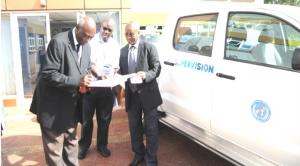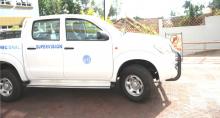WHO strengthens disease surveillance in Kampala city
Kampala, 26th May 2015:- The World Health Organization (WHO) donated a brand new Toyota Double Cabin vehicle to Naguru China Friendship Hospital to support the hospital’s Expanded Program on Immunization (EPI) and Integrated Disease surveillance and response supportive supervision. This was in addition to computers and other Information Technology equipment that were handed over in November 2014.
WHO’s Dr. Solomon Fisseha while handing over the vehicle, called upon the hospital management to provide on-job training to the EPI/Integrated Disease Surveillance and Response (IDSR) teams. He decried the timeliness and completeness of weekly reporting that are still low at only 8% as of May 2015. He hoped the vehicle would be used for its intended purposes such as improving immunization and health indicators in the Kampala Capital City Authority (KCCA) area of jurisdiction.
Dr. Edward Naddumba the Executive Director of Naguru Regional Hospital expressed gratitude on behalf of the hospital for the continued support received from WHO. With this support, coupled with presence of a public health expert at the hospital, Dr. Naddumba pledged to strengthen disease surveillance in KCCA.
One of the key strategies to revitalize routine immunization in Uganda is to scale up support supervision. In that regard, Regional EPI supervisors were appointed to provide regular monitoring and quality support supervision to districts for acute flaccid paralysis surveillance, IDSR, and immunization service delivery.
Since 2003, ten regions have been operationalized in phases based on the existing regional referral hospitals as the focal entry points for scaling up this function. The phases approach was preferred mainly because lessons from one region would be used in the subsequent regions. Naguru Regional Referral Hospital was brought on board in November 2014. The hospital supervises 9 districts of Greater Kampala Region that is, Buikwe, Buvuma, Kayunga, Gomba, Mukono Butambala Mpigi, Wakiso, and KCCA.
Surveillance is key in identifying disease outbreaks such as Ebola, Typhoid, Cholera and others. It is noted that with the ongoing outbreak of Typhoid, in Kampala city only 8% of health facilities are reporting which is unacceptably too low. Besides, the Ebola outbreak in West Africa offers bitter lesson of what weak disease surveillance can lead to.
Therefore Regional Supervisors are critical in strengthening disease surveillance through regular support supervision, mentoring and on the job training.
Role of WHO in Integrated Disease Surveillance Response in Uganda WHO offers technical guidance, supports training in IDSR and provides material and financial resources to ensure that disease surveillance is properly and regularly implemented in countries.
__________________________________________________
For more information, please contact:
Mwebembezi Edmond, Public Information Officer
Tel.: +256 414 335569
Cell: +256 782 962674
Email: wembembezie [at] who.int (mwembembezie[at]who[dot]int)
_________________________________________________
Below:
01. Left to Right Dr. Edward Naddumba signs onto the handover certificate acknowledging receipt as Dr. Bakainaga and Dr. Solomon Fisseha WHO look on
02. Officials from WHO and Naguru Regional Hospital who attended the handover ceremony
03. The brand new Toyota Double Cabin vehicle that was handed over to Naguru Regional Hospital at the WHO Country office






